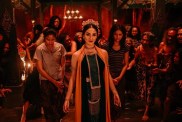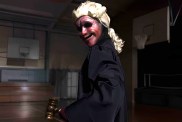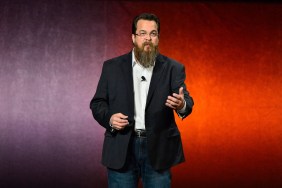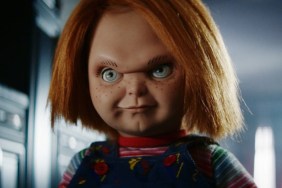On Saturday night, Syfy will air Leprechauns Revenge. Earlier Shock spoke with director Drew Daywalt. Writer Anthony C. Ferrante, a longtime writer for Fangoria and other genre publications, was kind enough to talk to Shock about the difference between writing about and working on horror movies, the importance of Syfy, putting a new spin on familiar stories, upcoming projects and more.

Anthony C. Ferrante: Its all about getting excited about the material. Whether its Im going to interview John Carpenter or this unknown actress or Im going to get to write a haunted house film. You have to get excited about what youre doing. I have always done the journalism and filmmaking in tandem, even when I did my short films. I looked at everything as a learning experience. Every person I interviewed, every set I visited, I tried to absorb as much as possible. I always loved horror movies, and when I covered films for Fangoria, I could see the love the filmmakers put into their films even when they didnt always turn out perfect. So I look at every opportunity I have as a writer or a filmmaker as a chance to do something cool and different regardless or budget or limitations.
Shock: With the success of found footage movies, micro-budget horror seems to be taking hold at every studio and production company. Syfy has been doing it that way for years and now with Syfy Films they are getting into the theatrical game. What is Syfy’s place in horror? Does the network get the credit it deserves? If you ask me some horror fans are too quick to thumb their noses at the network.
Ferrante: I always remind people that the Syfy Saturday Night Movie is the most successful anthology show on TV, even though its not officially referred to as an anthology series. I think theyve done well over 220 movies now. Each week you get something new – horror, sci-fi, disaster, hybrid monsters and a few surprises as well. Some youll like, some you wont, but thats like everything. I know some horror fans may thumb their noses at these films, but where else are you going to get this variety. And if you really break it down, the only difference between the movies theyre developing compared to big studio tentpoles is budget.
The outlets are getting few and far between where films like this can be made on a regular basis, get distribution and be seen. I think more people have seen Headless Horseman by watching it on Syfy then they have on DVD. I think its easy for fans to immediately dismiss what Syfy is doing, instead of appreciating that theyre keeping the genre alive and well.
Shock: What’s your approach to injecting new life into stories about somewhat familiar characters like a killer leprechaun and the Headless Horseman? What are the most important elements?
Ferrante: It goes back to getting excited about the material and figuring out how to get into the story. It also starts with what is this story about and how is the creature/monster/ghost connected to the movie from there. Its also important to really nail down the mythology. Thats the hardest part about any of these films is knowing the rules, understanding them and conveying them properly.
You also take a look at whats been done, and then try to do your own thing if you can. On Headless Horseman, I thought it would be cool that with every head the Horseman chops off, his own head grows back. So that would require different stages. Part of that concept was out of necessity. We couldnt digitally remove his head for the entire movie because it would have been cost prohibitive, but if he grew it back, we could do cool prosthetics, tentacles and other practical things with it. I also had Todd Masters doing effects, so I knew that stuff would look fantastic.
Its impossible to get those Warwick Davis Leprechaun movies out of your head, even though this has no association with it. So with Leprechauns Revenge, luckily, the network and After Dark (Films) wanted to do something different more creature-like. It was a chance for me to write something more fantastical than Ive done in the past. Scream of the Banshee was more of a monster movie, but doing something with a leprechaun was a chance to have more fantasy elements mixed with the horror.

Ferrante: I thought it would be interesting to do something more creepy and organic. What if the leprechaun was buried underneath an old tree for decades and it fed off the tree? The tree kept it alive, but the roots grew in and out of the leprechauns body trapping him within the earth. It made for some cool visuals. And from there, it was about making it more of a vicious creature, instead of the guy in the hat and clothes we associate with St. Patricks Day. Plus, we knew from the start the creature wasnt going to talk which is a huge difference and I didnt want it to be about I want me pot of gold. Gold plays an important part, but theres a nice twist to it in this film.
Also, coming from the special make-up effects world, if its possible, I usually like to pre-conceptualize even before the film is made whether Im a writer-for-hire, like I was here, or a writer-director. Jacob Hair, who has done storyboards for me from Boo on, and who I also wrote a couple of screenplays with, was hired by After Dark to work with me in conceptualizing what the leprechaun looked like even before I started writing the script. That way production could see how different this was; plus it also helped inspire some of the set pieces in the film once I started writing the script.
We did the same thing with the Four-Leaf Cleaver weapon in the movie. That started off as a joke I made saying they should call the movie this and then I thought it would be a cool weapon that could potentially stop the leprechaun four sharpened horseshoes attached to a staff. So Jake did an early design on that as well.
Having all this extra material really helps production once my job is done as a writer because the schedules and budget on these things are always very tight. After that, its up to the director and producers to use it as a springboard and starting off point for their own vision. Ive just found if you dont convey the intent of creatures or specialty props early on with the script and occasionally with designs, it could get misinterpreted down the road. If you just write four-leaf cleaver on the page and that’s it, inevitably, somewhere down the road someone will mistakenly think, oh, I get it, a meat cleaver with a shamrock on it. You dont really want that.
Shock: What should viewers expect from the movie? What’s your pitch to someone on the fence about tuning in Saturday night?
Ferrante: Its going to be a fun, reinvention of the leprechaun legend. Ive been a big fan of Drew Daywalts work, and I was thrilled he was going to direct this. Hes really brought his unique style to the mix and really brought the fantastical elements to life. Its got some nice gory kills, it has a dark sense of humor and the photography is real slick. Saturday is also St. Patricks Day, so what better way to spend a night getting drunk on green beer and watching a Leprechaun ripping peoples throats out.
Shock: What’s on the horizon for you?
Ferrante: I wrote the story for a film called Haunted High, which is out in the fall, and theres an untitled ghost story that I just scripted which is going into production soon and will be out in October. Im also developing a spooky sci-fi horror film with producers Patti Beninati and Michael K. Anderson.
Im also really excited about an ambitious genre film called The Key which I wrote with Jake and which Ill direct. We already have around 30 pieces of conceptual art completed for that. Its very different, but its not a sequel or remake, so its taken some time to raise the funding for it. Thats still a ways off. Boo took some time to get funding too, so Ive learned to be very Zen and patient.









